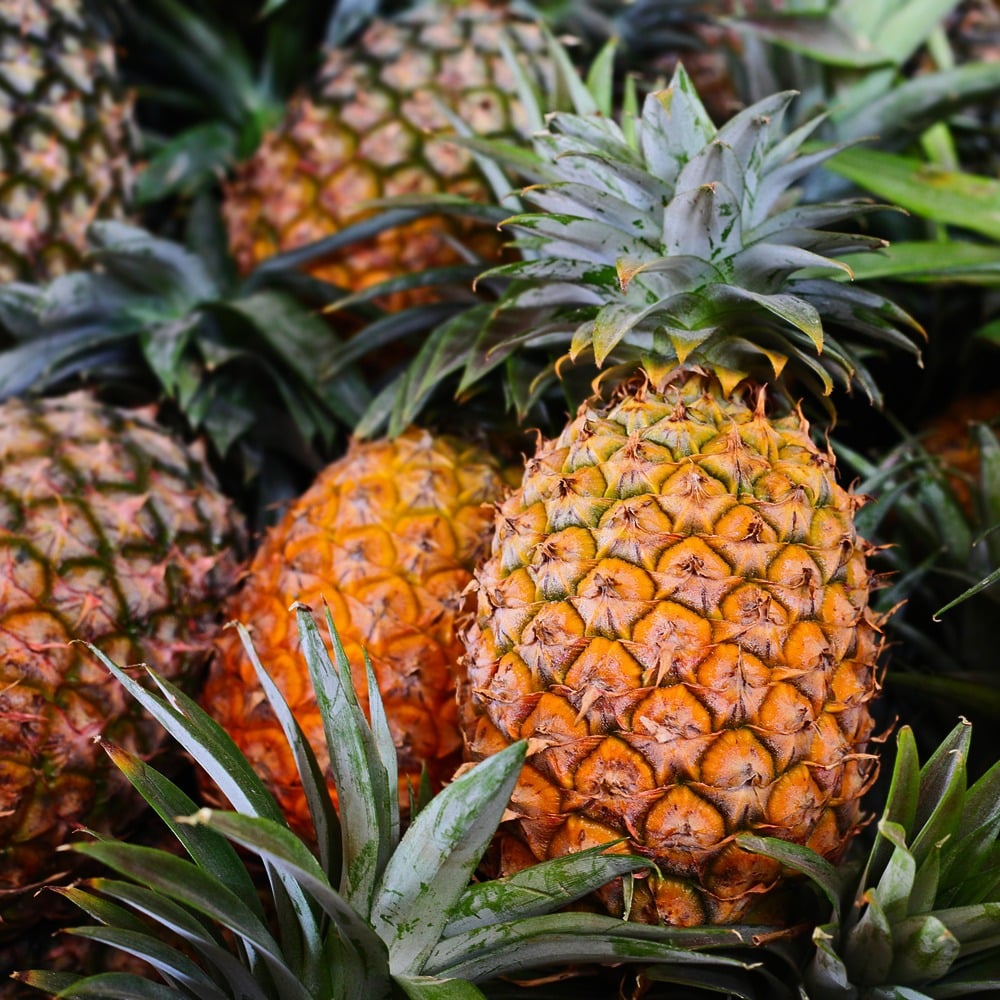Pineapple is rich in vitamin C which will help to support the immune system and provide potent antioxidant benefits. Just one cup contains around 79 mg of vitamin C according to the USDA, which is more than the daily recommended value for women and just shy of the recommendation for men. Vitamin C is important to the body not only because of boosting the immune system, but it also encourages growth and healing around the body, and it plays roles in everything from wound repair to iron absorption.
A report published in Food Science and Biotechnology found that pineapple juice helped to decrease fat formation and increase fat breakdown. Meaning that it may help to promote weight loss. Even if it did not have any effect on metabolism, it is still a good choice because it is low in calories, high in vitamins/minerals, and does not have any trans fats or saturated fats. It can also serve as a substitute for that sweet craving with its natural sweetness and fiber content, which can help to control blood sugar levels as well as help you to eat less, according to the Mayo Clinic.
Pineapple may help with digestion due to the bromelain mix of enzyme content that has been shown to reduce inflammation and nasal swelling as well as aiding in the healing of wounds and burns, according to the NCCIH. It has also been linked to improved digestion and has traditionally been used to treat digestive disorders. A report published in Biotechnology Research International found that the bromelain in pineapple helped to reduce the effects of diarrhea.
Pineapple contains a trace source of calcium and manganese which is essential for maintaining bone health according to the University of Rochester Medical Center. One cup of pineapple contains around 76% of the DRV of manganese, and it may be one of the top sources of the mineral according to Oregon State University. A report published in The Open Orthopaedics Journal, suggests that it may help to stave off osteoporosis and help to improve overall bone health as well as mineral density, but be sure not to overdo it because manganese can be dangerous and increase the risk of cognitive disorders if you exceed more than 11 mg a day. When it comes to reaching the dangerous levels of manganese you would need to eat a lot of pineapples as one cup has less than 1 mg of manganese.
A report published in Molecules suggests that pineapples are a great source of anti-aging antioxidants, specifically vitamin C, phenolics, and flavonoids that can help the body fight inflammation and harmful free radicals that can cause cellular damage that leads to a variety of health issues such as heart disease and eye problems among others. Antioxidants help to fight off these free radicals and may also reduce the risk of developing cancer, according to Stanford Health Care. The American Journal of Clinical Nutrition published a report finding that diets and blood concentrations that are high in antioxidants were associated with a lower risk of cancer.
While inflammation is a natural immune response that is a good thing, it is also a double-edged sword as too much inflammation can lead to a variety of diseases such as coronary artery disease, cancer, Alzheimer’s disease, and arthritis among others according to Harvard Health. Diets that are rich in anti-inflammatory foods, which includes pineapples, have been shown to help reduce the amount of inflammation in the body. A report published in Biomedical Reports indicates that the bromelain content in pineapples is responsible for their anti-inflammatory properties.
The next time you feel a cold coming on while reaching for oranges add in some pineapple to help boost your immune system. A report published in the Journal of Nutrition and Metabolism found that kids who ate canned pineapples experienced fewer viral and bacterial infections compared to those who didn’t eat any; as such the researchers concluded that 140-280 grams of pineapple per day may help to reduce the likelihood of an infection or at least shorten its duration.
One cup of pineapple chunks contains around 82.5 calories, 1.7 grams of fat, 1 gram of protein, 21.6 grams of carbs, 2.3 grams of fiber, 131% of the daily recommended values for vitamin C, 76% of the DRV for manganese, 9% DRV of vitamin B6, 9% DRV of copper and thiamin, 7% of the DRV of folate, 5% of the DRV of potassium and magnesium, 4% of the DRV of niacin and pantothenic acid, 3% of the DRV of riboflavin, and 3% of the daily recommended value for iron.
Pineapple is also involved in a culinary debate: Does pineapple belong on pizza?
While there have been numerous polls, the results vary from side to side. There is no single general consensus, and this debate can continue endlessly as people’s opinions on this matter vary widely.
Pineapple as a topping is commonly associated with a popular style of pizza that was created in Canada in 1962 called a Hawaiian pizza, which typically includes ham, bacon, and pineapple. Whether you like it or not, pineapple has become a fan favorite, hitting that sweet and savory spot in many homes around the globe.




